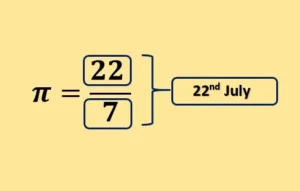
I welcome my wonderful readers to a celebration of mathematics and wonder! Today, we delve into the enchanting realm of Pi Approximation Day, where we shall unlock the secrets of this fascinating and infinite number.
History of Pi
The Ancient Roots
The tale of Pi begins in ancient civilizations. Egyptians and Babylonians both attempted to approximate the value of Pi recognizing its significance in geometry. However, it was the ancient Greeks who truly embraced Pi.
Archimedes’ Ingenious Approximation
It was ancient Greece, where the brilliant mathematician Archimedes unveiled a groundbreaking discovery around 250 BCE. Employing polygons, Archimedes ingeniously approximated Pi. He proved that it lies between 22/7 and 223/71. His remarkable insight laid the groundwork for future investigations into this infinite number.
Approximating Pi with Ingenuity
Aryabhata in his renowned work “Aryabhatiyam,” presented a groundbreaking approximation of Pi. He devised an elegant and surprisingly accurate value for this enigmatic constant. This laid the foundation for future generations to explore its wonders.
With astute insights and keen mathematical prowess, Aryabhata declared that the ratio of the circumference of a circle to its diameter is not an arbitrary number, but an unchanging constant. He approximated this unvarying value, now famously known as Pi, to 3.1416—a remarkable feat considering the era in which he lived.

The Symbolic π Emerges
As mathematical knowledge expanded, so did the fascination with Pi. The symbol “π” was first introduced in the 18th century by the Welsh mathematician William Jones. Little did he know that this simple, yet powerful, symbol would come to represent one of the most fundamental constants in mathematics.
Pi’s Decimal Expansion Unveiled
In the 16th century, Flemish mathematician Simon Stevin made significant strides in decimal notation. Finally, paved the way for understanding the decimal expansion of π. This progress sparked a flurry of efforts to calculate π’s digits with greater precision igniting a race among mathematicians to push the boundaries of computation.
Enter Modern Computing Power
Advancements in technology during the 20th and 21st centuries propelled the quest for more accurate digits of π. From early computers to supercomputers and now cloud computing, researchers continue to calculate π to billions and trillions of digits, uncovering the mysteries of this infinite number.
Understanding Pi and its Significance
Let’s start by unveiling the mystery behind π. Pi (π) is an irrational number, approximately equal to 3.14159, but it extends infinitely without any repeating pattern. It has captivated mathematicians, scientists and artists for centuries revealing its presence in various aspects of the natural world.
Pi Approximation Day falls on a special date, 22nd July, written as 22/7, where 22 represents the day and 7 the month. Coincidentally, the fraction 22/7 is a common approximation of π, further adding to the significance of this unique day.
Optimizing Life with Pi’s Infinite Wisdom
Though Pi Approximation Day is not widely known, we can use this occasion to optimize our lives, much like optimizing the value of π itself. Allow me to share some valuable life lessons we can draw from this celebrated mathematical constant:
Embrace the Infinite
Just as π extends infinitely, so does the potential of our own growth and creativity. Let us remember that possibilities are endless. We should never underestimate our capacity to achieve greatness.
Finding Harmony in Diversity
Its decimal expansion never repeats, demonstrating the beauty of diversity. Likewise, we can celebrate our differences and come together in harmony. We should respect and value the uniqueness of each individual. And of course, it is the need of the hour to put an end to the violence that is burning, the beautiful Manipur. Moreover, to stop and prevent any such incident in future.
Resilience in Adversity
It is non-repeating nature teaches us the virtue of resilience. In the face of challenges, remember that like Pi, we too can persevere and overcome obstacles on our journey to success.
Balancing Precision and Flexibility
Its value is precise, yet it remains an approximation due to its infinite nature. Likewise, in our pursuits, let’s strike a balance between precision and flexibility. We should recognize that perfection is a continuous journey and not a fixed destination.
Uniting the Arts and Sciences
π’s influence spans across various disciplines, just as art and science are interconnected in their pursuit of truth and beauty. Let us use this day to celebrate the amalgamation of creativity and logic in our lives.
Encouraging a Growth Mindset
Just as mathematicians explore the infinite digits of π, we should adopt a growth mindset and continuously seek knowledge learning from every experience and expanding our horizons.
Appreciating the Beauty of Pi in Nature
As we bask in the glory of this Day, let’s not forget to appreciate the occurrence of π in the natural world. From the patterns of the Fibonacci sequence in flowers to the calculations of the circumference of celestial bodies, π’s fingerprints are everywhere.
Architects, artists, and musicians also find inspiration in π’s elegance. The Parthenon’s design in Greece and the mesmerizing melodies of musical compositions are but a few examples of π’s influence on human creativity.
Concluding words
Today, we have explored the enchanting world of π discovering the wonders of this infinite and mystical number. Remember to celebrate the beauty of mathematics in our lives, embracing the diversity of ideas and fostering a growth mindset.
As we bid adieu to this day, let us carry the spirit of π with us, optimizing our lives with its wisdom and appreciating its presence in the natural world and human creations. So, fellow enthusiasts, let’s cherish the magic of Pi Approximation Day every year and continue exploring the mysteries that lie within this captivating mathematical constant.
Happy Pi Approximation Day!

Very interesting and informative article..keep updating your readers with such articles.
Thank you 🙌
Very Informative article